engine Citroen C4 RHD 2015 2.G Owner's Guide
[x] Cancel search | Manufacturer: CITROEN, Model Year: 2015, Model line: C4 RHD, Model: Citroen C4 RHD 2015 2.GPages: 328, PDF Size: 12.72 MB
Page 70 of 328

68
Lost keys
Go to a CITROËN dealer with the vehicle's registration document, your personal
identification documents and if possible the key code label.
The
CITROËN
dealer
will
be
able
to
look
up
the
key
code
and
the
transpon
-
der
code required to order a new key. Do
not
throw
the
remote
con
-
trol batteries away, they contain
metals which are harmful to the environment.
T
ake
them
to
an
approved
col
-
lection
point.
Remote control
The high frequency remote control is a sensitive system; do not operate it while
it is in your pocket as there is a possibility that it may unlock the ve -
hicle,
without you being aware of it.
Do
not
repeatedly
press
the
buttons
of
your
remote
control
out
of
range
and
out
of
sight
of
your
vehicle.
Y
ou
run
the
risk
of
stopping
it
from
working
and
the
remote control would have to be reinitialised.
No
remote
control
can
operate
when
the
key
is
in
the
ignition
switch,
even
when
the ignition is switched off, except for reinitialisation.
Locking the vehicle
Driving with the doors locked may make access to the passenger compart -
ment by the emergency services more difficult in an emergency.
As
a
safety
precaution,
never
leave
children
alone
in
the
vehicle,
except
for
a
very short period.
In
all
cases,
it
is
essential
to
remove
the
key
from
the
ignition
switch
when
leaving
the vehicle.
Anti-theft protection
Do not make any modifications to the electronic engine immobiliser system; this
could cause malfunctions.
When purchasing a second-hand vehicle
Have the pairing of all of the keys in your possession checked by a CITROËN
dealer , to ensure that only your keys can be used to open and
start
the vehicle.
4
ACCESS
Page 75 of 328

73
DOORS
Opening
F After unlocking the vehicle com -
pletely using the remote control or
the
key, pull the door handle.
From outside
When
the
selective
unlocking
is
activated,
the
first
press
of
the
remote
control
unlocking
button
permits
unlocking
of
the
driver's
door
only. F
Pull the
interior control lever of a
front
door;
this
unlocks
the
vehicle
completely
.
From inside
With
the
selective
unlocking
ac
-
tivated:
-
opening
the
driver's
door
un
-
locks
the
driver's
door
only
(if
the
vehicle
has
not
already
been
completely unlocked).
-
opening
the
passenger's
door
unlocks
the
rest
of
the
vehicle.
The
interior
door
controls
do
not operate when the vehicle is
deadlocked.
Closing
When a door is not closed correctly:
-
when the engine is run
-
ning,
this
warning
lamp
comes
on,
accompanied
by
an
alert
message
for
a
few
seconds,
-
when the vehicle is moving
(speed
higher
than
6
mph
(10
km/h)),
this
warning
lamp
comes
on,
accom
-
panied
by
an
alert
message
for
a
few
seconds.
4
ACCESS
Page 76 of 328
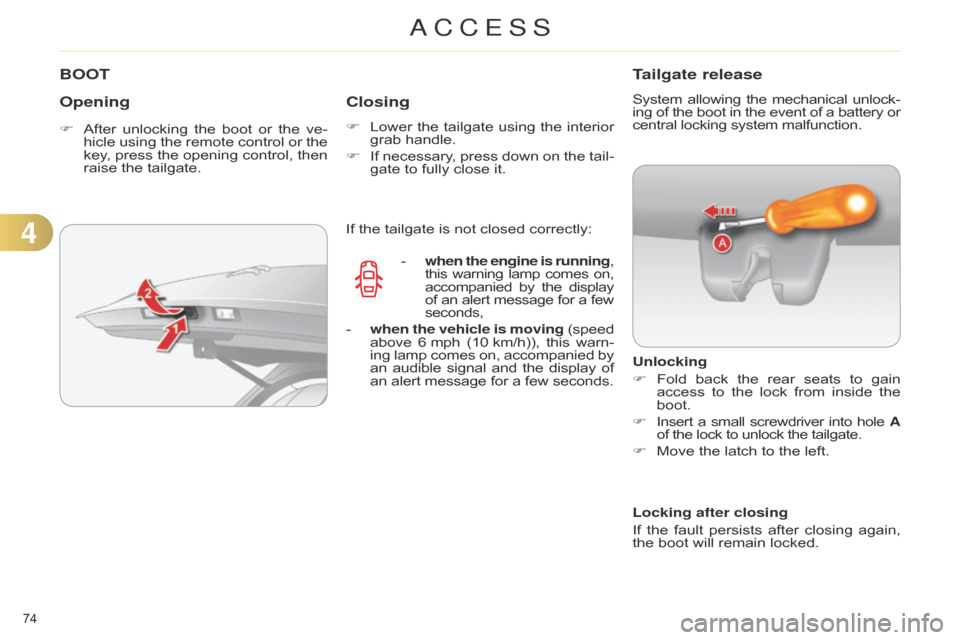
74
BOOT
Opening
F After unlocking the boot or the ve -
hicle using the remote control or the
key
,
press
the
opening
control,
then
raise
the tailgate.
Closing
F Lower the tailgate using the interior grab
handle.
F
If
necessary
,
press
down
on
the
tail
-
gate
to fully close it.
Tailgate release
System allowing the mechanical unlock -
ing of the boot in the event of a battery or central
locking system malfunction.
Unlocking
F
Fold
back
the
rear
seats
to
gain
access
to
the
lock
from
inside
the
boot.
F
Insert
a
small
screwdriver
into
hole
A
of
the lock to unlock the tailgate.
F
Move
the latch to the left.
If
the
tailgate
is
not
closed
correctly:
-
when
the engine is running,
this
warning
lamp
comes
on, accompanied
by
the
display of
an
alert
message
for
a
few seconds,
-
when the vehicle is moving
(speed above
6
mph
(10
km/h)),
this
warn
-
ing
lamp
comes
on,
accompanied
by an
audible
signal
and
the
display
of an
alert
message
for
a
few
seconds. Locking after closing
If
the
fault
persists
after
closing
again,
the
boot will remain locked.
4
ACCESS
Page 81 of 328
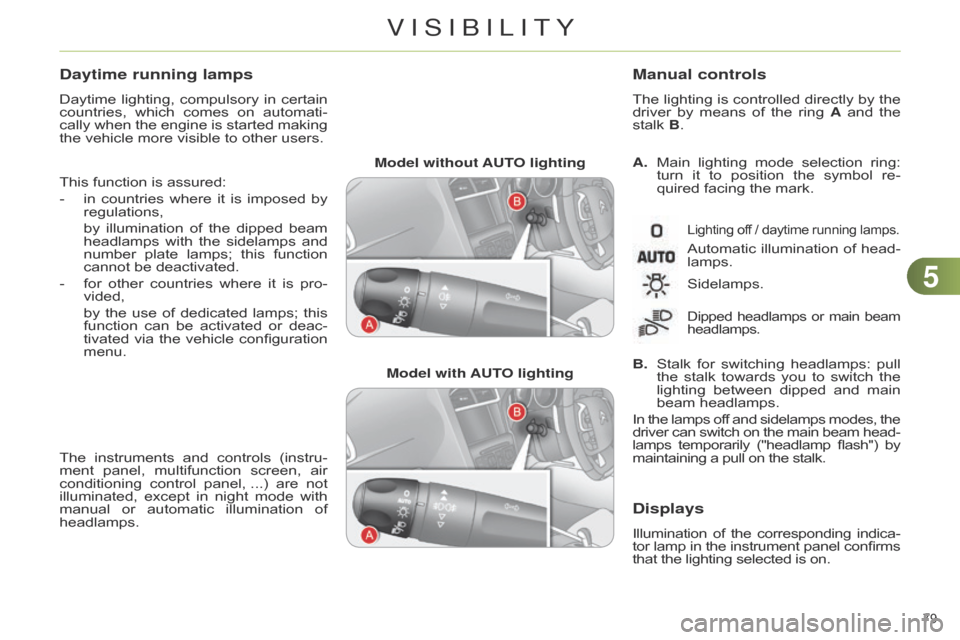
55
79
Model without AUTO lightingModel with AUTO lighting A.
Main lighting mode selection ring: turn
it to position the symbol re -
quired
facing the mark.
Manual controls
The lighting is controlled directly by the driver
by means of the ring A and the
stalk
B.
Lighting off / daytime running lamps.
Automatic illu mination of head -
lamps.
B.
Stalk
for
switching
headlamps:
pull
the
stalk
towards
you
to
switch
the
lighting
between
dipped
and
main
beam
headlamps.
In
the
lamps
of
f
and
sidelamps
modes,
the driver
can
switch
on
the
main
beam
head
-
lamps
temporarily
("headlamp
flash")
by maintaining
a pull on the stalk.
Sidelamps.
Dipped headlamps
or main beam headlamps.
Displays
Illumination of the corresponding indica -
tor lamp in the instrument panel confirms that
the lighting selected is on.
Daytime running lamps
Daytime lighting, compulsory in certain countries,
which comes on automati -
cally
when
the
engine
is
started
making
the
vehicle more visible to other users.
This
function is assured:
-
in
countries
where
it
is
imposed
by
regulations,
by
illu
mination
of
the
dipped
beam
headlamps
with
the
sidelamps
and
number
plate
lamps;
this
function
cannot
be deactivated.
-
for
other
countries
where
it
is
pro
-
vided,
by
the
use
of
dedicated
lamps;
this
function
can
be
activated
or
deac
-
tivated
via
the
vehicle
configuration
menu.
The
instruments
and
controls
(instru
-
ment
panel,
multifunction
screen,
air
conditioning
control
panel,
...)
are
not
illu
minated,
except
in
night
mode
with
manual
or
automatic
illu
mination
of
headlamps.
VISIBILITY
Page 90 of 328

55
88
Automatic rain sensitive
windscreen wipers
The windscreen wipers operate automat -
ically, without any action on the part of
the
driver
,
if
rain
is
detected
(sensor
be
-
hind
the
rear
view
mirror),
adapting
their speed
to the intensity of the rainfall.
Briefly
push
stalk
A
down
-
wards.
The
instruction
is
confirmed
by
a
wiping
cycle,
accompanied
by
illumination
of
this
warning
lamp
in
the
instrument
panel
and
an
activation
message. Switching on
Switching off Operating fault
If
an
automatic
rain
sensitive
wiper
mal
-
function occurs, the wipers will operate
in
intermittent mode.
Contact
a
CITROËN
dealer
or
a
quali
-
fied
workshop.
d
o not cover the rain sensor,
linked
with
the
sunshine
sensor
and
located
in
the
centre
of
the
windscreen
behind
the
rear
view
mirror
.
Switch
of
f
the
automatic
rain
sensitive
wipers
when
using
an
automatic
car wash.
In
winter
,
it
is
advisable
to
wait until
the
windscreen
is
completely clear
of
ice
before
activating
the automatic
rain sensitive wipers.
The
automatic
rain
sensitive
windscreen
wipers
must
be
re
-
activated if the ignition has been of
f for more than one minute.
Briefly
push
stalk
A
downwards
again.
The
instruction
is
confirmed
by
this
warning
lamp
going
of
f
in
the
instrument
panel
and/or
the
display
of
a deactivation message.
Windscreen and headlamp
wash
Low screenwash / headlamp wash
fluid level
On
vehicle
fitted
with
headlamp
wash
-
ers,
the
low
level
of
this
fluid
is
indicat
-
ed
by
gauge
in
the
reservoir
filler
neck
under
the bonnet.
Checking
and
topping
up
this
fluid
can
should
be done with the engine off.
The
level
of
this
fluid
should
be
checked
regularly
, particularly during winter.
Refer
to
"Checks
-
Screenwash
/
head
-
lamp
wash
level"
section
for
the
proce
-
dure
on checking the level.
F
Pull
the
windscreen
wiper
stalk
to
-
wards
you.
The
windscreen
wash
then
the
windscreen
wipers
operate
for
a fixed period.
The
headlamp
washers
only
operate when
the dipped or main beam head
-
lamps are on, with the vehicle moving.
To
reduce
the
consumption
of
the
fluid
by
the
headlamp
wash
-
ers, they operate only with every
seventh use of the screenwash
or
every
25
miles
(40
km)
during
a
given journey.
VISIBILITY
Page 92 of 328
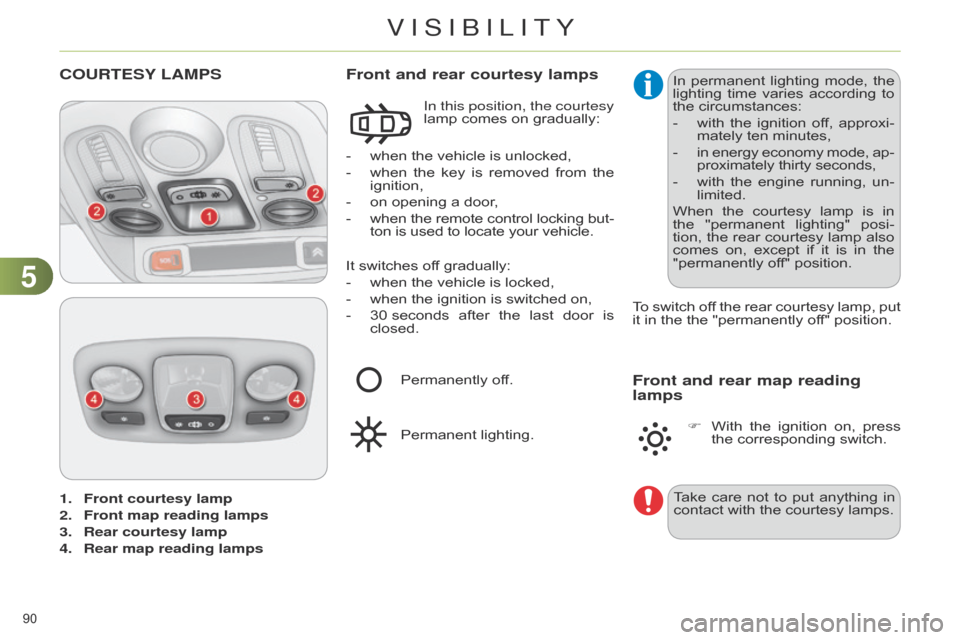
55
90
1. Front courtesy lamp
2.
Front map reading lamps
3.
Rear courtesy lamp
4.
Rear map reading lamps
COURTESY LAMPS
- when the vehicle is unlocked,
-
when
the
key
is
removed
from
the
ignition,
-
on
opening a door,
-
when
the
remote
control
locking
but
-
ton
is used to locate your vehicle.
Front and rear courtesy lamps
In this position, the courtesy
lamp comes on gradually:
It
switches
off gradually:
-
when
the vehicle is locked,
-
when
the ignition is switched on,
-
30
seconds
after
the
last
door
is
closed. T
o
switch
of
f
the
rear
courtesy
lamp,
put
it
in the the "permanently off" position.
Permanently
off.
Permanent
lighting. In
permanent
lighting
mode,
the
lighting
time varies according to the
circumstances:
-
with
the
ignition
of
f,
approxi
-
mately
ten minutes,
-
in
energy
economy
mode,
ap
-
proximately
thirty seconds,
-
with
the
engine
running,
un
-
limited.
When
the
courtesy
lamp
is
in
the
"permanent
lighting"
posi
-
tion,
the
rear
courtesy
lamp
also
comes
on,
except
if
it
is
in
the
"permanently
off" position.
Front and rear map reading
lamps
Take care not to put anything in contact
with the courtesy lamps.
F
With
the
ignition
on,
press
the
corresponding switch.
VISIBILITY
Page 93 of 328

55
91
INTERIOR MOOD LIGHTING
The dimmed passenger compartment lighting
improves visibility in the vehicle
when
the light is poor.
Switching on
At night, two interior mood lamps in the front courtesy lamp come on automatically
when
the
sidelamps
are
switched
on.
Switching off
The interior mood lighting switches of f automatically
when the sidelamps are
switched
off.
It
can
be
switched
of
f
manually
by
ad
-
justing
the
instrument
panel
lighting rheostat button to one of the lowest set
-
tings.
This
comes
on
automatically
when
the
boot
is
opened
and
goes
of
f
automati
-
cally
when the boot is closed.
BOOT LAMP
The lighting time varies accord -
ing to the circumstances:
-
when
the
ignition
is
of
f,
ap
-
proximately
ten minutes,
-
in
energy
economy
mode,
ap
-
proximately
thirty seconds,
-
when
the
engine
is
running,
no
limit.
VISIBILITY
Page 121 of 328
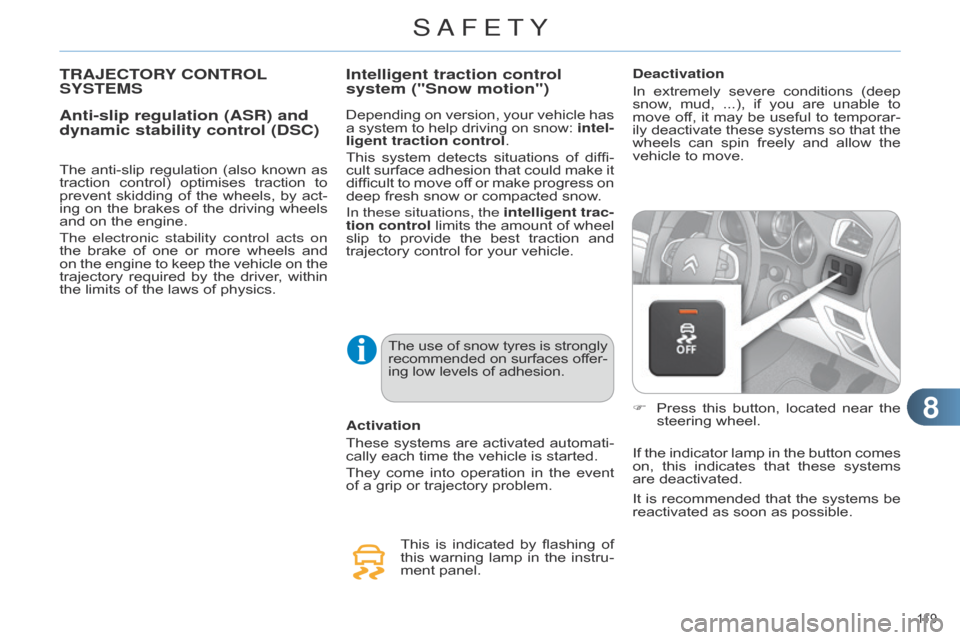
88
119
TRAjECTORY CONTROL SYSTEMS
Anti-slip regulation (ASR) and
dynamic stability control (DSC)
The anti-slip regulation (also known as traction
control) optimises traction to
prevent
skidding
of
the
wheels,
by
act
-
ing
on
the
brakes
of
the
driving
wheels
and
on the engine.
The electronic stability control acts on
the
brake
of
one
or
more
wheels
and
on
the
engine
to
keep
the
vehicle
on
the
trajectory
required
by
the
driver
,
within
the
limits of the laws of physics.
Activation
These
systems
are
activated
automati
-
cally
each time the vehicle is started.
They
come
into
operation
in
the
event
of
a grip or trajectory problem.
This
is
indicated
by
flashing
of
this
warning
lamp
in
the
instru
-
ment
panel.
Intelligent traction control
system ("Snow motion")Deactivation
In
extremely
severe
conditions
(deep
snow
,
mud,
...),
if
you
are
unable
to
move
of
f,
it
may
be
useful
to
temporar
-
ily
deactivate
these
systems
so
that
the
wheels
can
spin
freely
and
allow
the
vehicle
to move.
F
Press
this
button,
located
near
the
steering
wheel.
If
the
indicator
lamp
in
the
button
comes
on,
this
indicates
that
these
systems
are
deactivated.
Depending
on
version,
your
vehicle
has
a
system
to
help
driving
on
snow:
intel
-
ligent traction control.
This
system
detects
situations
of
diffi
-
cult
surface
adhesion
that
could
make
it
difficult
to
move
of
f
or
make
progress
on
deep
fresh
snow
or
compacted
snow.
In these situations, the intelligent trac-
tion control
limits
the
amount
of
wheel
slip
to
provide
the
best
traction
and
trajectory
control
for
your
vehicle.
The
use
of
snow
tyres
is
strongly recommended
on
surfaces
of
fer-
ing
low
levels
of
adhesion. It
is
recommended
that
the
systems
be
reactivated
as soon as possible.
SAFETY
Page 124 of 328
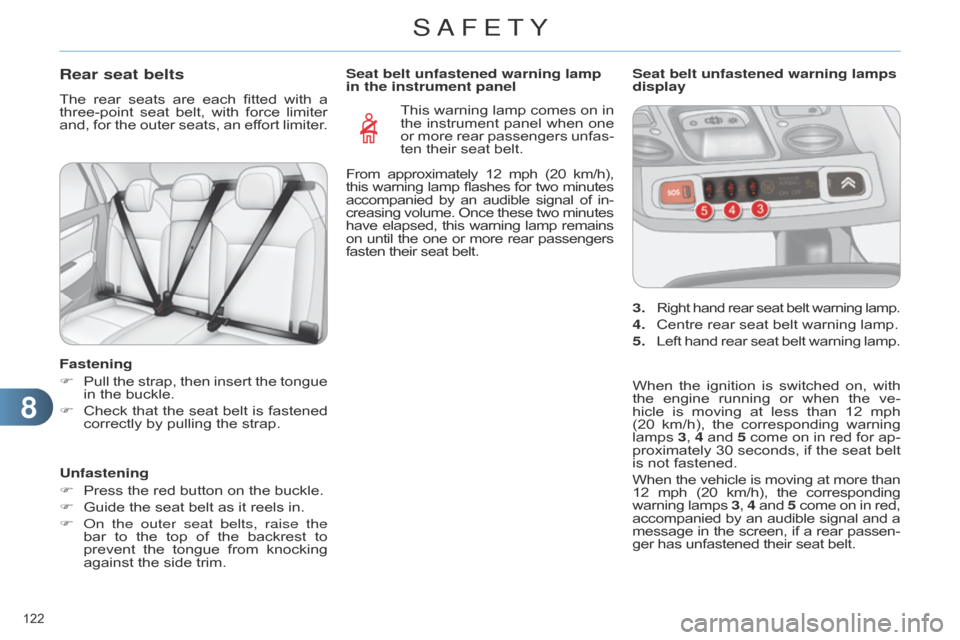
88
122
Rear seat belts
The rear seats are each fitted with a three-point
seat belt, with force limiter
and,
for
the
outer
seats,
an
ef
fort
limiter
.
Fastening
F
Pull
the
strap,
then
insert
the
tongue
in
the buckle.
F
Check
that
the
seat
belt
is
fastened
correctly
by pulling the strap.
Unfastening
F
Press
the red button on the buckle.
F
Guide
the seat belt as it reels in.
F
o n the outer seat belts, raise the
bar
to
the
top
of
the
backrest
to
prevent
the
tongue
from
knocking
against
the side trim. This
warning lamp comes on in
the
instrument
panel
when
one
or
more
rear
passengers
unfas
-
ten
their seat belt.
Seat belt unfastened warning lamp
in the instrument panel
3.
Right hand rear seat belt warning lamp.
4. Centre rear seat belt warning lamp.
5.
Left
hand
rear
seat
belt
warning
lamp.
Seat belt unfastened warning lamps
display
When
the
ignition
is
switched
on,
with
the
engine
running
or
when
the
ve
-
hicle
is
moving
at
less
than
12
mph
(20
km/h),
the
corresponding
warning
lamps
3
, 4
and
5
come
on
in
red
for
ap
-
proximately
30
seconds,
if
the
seat
belt
is
not fastened.
When
the
vehicle
is
moving
at
more
than 12
mph
(20
km/h),
the
corresponding warning
lamps
3, 4 and
5 come
on
in
red, accompanied
by
an
audible
signal
and
a message
in
the
screen,
if
a
rear
passen
-
ger
has unfastened their seat belt.
From
approximately
12
mph
(20
km/h),
this
warning
lamp
flashes
for
two
minutes accompanied
by
an
audible
signal
of
in
-
creasing
volume.
Once
these
two
minutes have
elapsed,
this
warning
lamp
remains on
until
the
one
or
more
rear
passengers fasten
their
seat
belt.
SAFETY
Page 130 of 328

99
128
A FEW DRIVING RECOMMENDATIONS
Observe the driving regulations at all times
and remain vigilant whatever the
traffic
conditions.
Pay
close
attention
to
the
traffic
and
keep
your
hands
on
the
wheel
so
that
you
are
ready
to
react
at
any
time
to
any
eventuality.
On
a
long
journey
,
a
break
every
two hours
is strongly recommended.
In
difficult
weather
,
drive
smoothly
,
an
-
ticipate
the
need
to
brake
and
increase
the
distance from other vehicles.
Driving on flooded roads
We strongly advise against driving on flooded
roads, as this could cause seri -
ous
damage
to
the
engine
or
gearbox,
as
well
as
to
the
electrical
systems
of
your
vehicle.
Important!
Never drive with the parking brake
applied - Risk of overheat -
ing
and
damage
to
the
braking
system!
Do
not
park
or
run
the
engine when
stationary in areas where
inflammable substances and ma -terials (dry grass, dead leaves...) might
come into contact with the hot
exhaust
system
-
Risk
of
fire!
n
ever leave a vehicle unsuper-
vised
with
the
engine
running.
If
you have to leave your vehicle
with
the
engine
running,
apply
the
parking
brake
and
put
the
gearbox
into
neutral
or
posi
-
tion
N
or P,
depending
on
the
type
of gearbox.
If
you
are
obliged
to
drive
through
water:
-
check
that
the
depth
of
water
does
not
exceed
15
cm,
taking
account
of
waves
that
might
be
generated
by
other users,
-
deactivate
the
Stop
&
Start
system,
-
drive
as
slowly
as
possible
without
stallin
g.
In
all
cases,
do
not
exceed
6
mph
(10
km/h),
-
do
not
stop
and
do
not
switch
of
f
the
engine.
On
leaving
the
flooded
road,
as
soon
as
circumstances
allow
,
make
several
light
brake
applications
to
dry
the
brake
discs
and
pads.
If
in
doubt
on
the
state
of
your
vehicle,
contact
a
CITROËN
dealer
or
a
quali
-
fied
workshop.
DRIVING